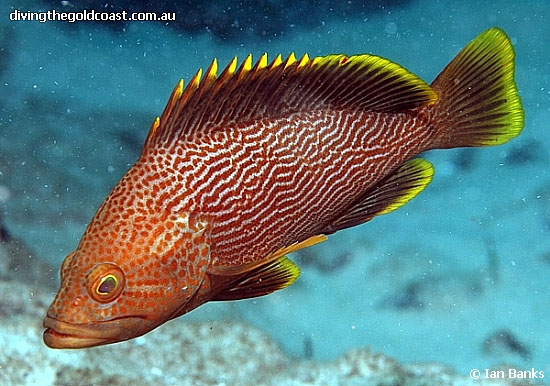| Epinephelidae (Groupers) |
| 61 cm TL (male/unsexed); max.weight: 5,500.0 g |
|
reef-associated; marine; depth range 27 - 80 m |
| Western Pacific: endemic to Australia, from southern Queensland (One Tree Islands, Great Barrier Reef at 23°30'S) to Bateman's Bay (35°44'S), New South Wales. One specimen was reported from Kangaroo Islands, South Australia. |
|
Dorsal spines (total): 11-11; Dorsal soft rays (total): 15-17; Anal spines: 3-3; Anal soft rays: 8-8. Interorbital area convex, Almost straight dorsal profile; preopercle sub angular, serrae slightly enlarged; upper edge of the operculum almost straight; nostrils subequal; maxilla reaches to or slightly beyond vertical at posterior edge of the eye. Pectoral fins fleshy; pelvic fins not reaching anus, except in small individuals. Pyloric caeca 11. Characterized further by the following: buff body, covered with close-set wavy longitudinal brownish orange, golden brown or reddish brown stripes; some stripes broken into series of small spots; pale greyish brown head, covered with small spots same as on the body; orange-brown maxillary streak; pale fin rays, with small brown spots, inter-radial membranes dark brown; narrow yellow margins on median fins; pectoral fins diffusely yellow distally (Ref. 89707). |
| Inhabits coral reefs (Ref. 58652) and rocky areas. It is an active swimmer that will leave the bottom to take a floating bait. |
|
Least Concern (LC); Date assessed: 22 November 2016 Ref. (130435)
|
| harmless |
Source and more info: www.fishbase.org. For personal, classroom, and other internal use only. Not for publication.
